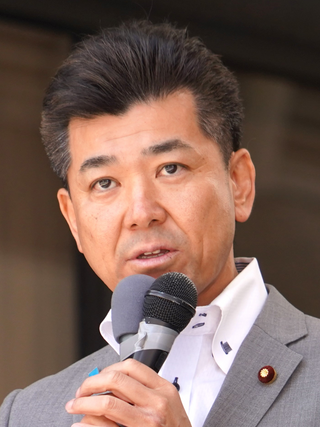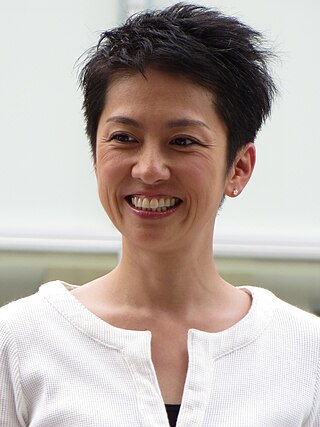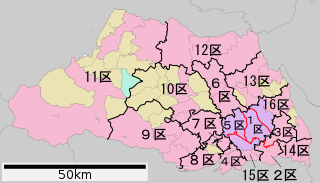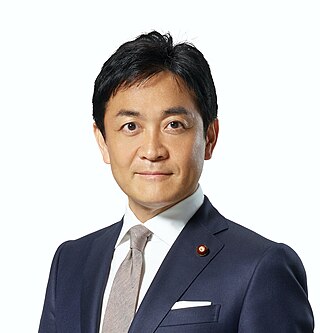
The Democratic Party of Japan was a centrist to centre-left, liberal or social-liberal political party in Japan from 1998 to 2016.
Japanese liberalism(自由主義 or リベラリズム) formed in the nineteenth century as a reaction against traditional society. In the twentieth century 'liberal' (自由) gradually became a synonym for conservative, and today the main conservative party in the country is named Liberal Democratic Party. The defunct Democratic Party was considered in part a centrist-liberal party, as are most parties which derived from it. The liberal character of the Liberal League is disputed, as it is also considered to be conservative by some. This article is limited to liberal (リベラル) parties with substantial support, proved by having had representation in parliament.

Renhō Saitō, known mononymously as Renhō, is a Japanese politician and former journalist who served as member of the House of Councillors from 2004 to 2024. She was the leader of the now-defunct major opposition party, the Democratic Party from 2016 to 2017. Renhō was a candidate for the 2024 Tokyo gubernatorial election with the support of the Constitutional Democratic Party (CDP), Japanese Communist Party (JCP), and the Social Democratic Party (SDP), but was defeated by incumbent Yuriko Koike, placing third behind Shinji Ishimaru.

Seiji Maehara is a Japanese politician who has been a member of the House of Representatives of Japan since 1993. He founded and led the political party, Free Education for All, before its merger into Nippon Ishin no Kai on 3 October 2024.

Akira Nagatsuma is a Japanese politician of the Constitutional Democratic Party of Japan (CDP), a member of House of Representatives in the Diet. Nagatsuma is currently the deputy leader and the head of the Tokyo chapter of the CDP. He had served as the Minister of Health, Labour and Welfare in the Hatoyama and Kan administration. He came to prominence when he reported missing records of public pension plans. A native of Nerima, Tokyo and graduate of Keio University, he was elected for the first time in 2000 after unsuccessful runs in 1995 and 1996.

Goshi Hosono is a Japanese politician and a member of the House of Representatives in the Diet. A native of Ōmihachiman, Shiga and graduate of Kyoto University, he was elected to the House of Representatives for the first time in 2000. He was the Minister of Environment and Minister of State for Nuclear Power Policy and Administration in the cabinet of Yoshihiko Noda. He represents the 5th District of Shizuoka prefecture.

Kenta Izumi is a Japanese politician who served as leader of the Constitutional Democratic Party of Japan (CDP) from 2021 to 2024. He is also a member of the House of Representatives in the National Diet, currently for the Kyoto 3rd district. He was first elected in 2000 under the Democratic Party of Japan. He served as Parliamentary Vice-Minister of the Cabinet Office from 2009 to 2010. After that, he served as chairman of the National Diet Measures Committee and Political Affairs Research Chairman of the Kibō no Tō, the Democratic Party for the People, and the Constitutional Democratic Party of Japan.

Yukio Edano is a Japanese politician who served as the leader of the Constitutional Democratic Party of Japan from its formation in 2017 until 2021.

Junya Ogawa is a Japanese politician of the Constitutional Democratic Party, and a member of the House of Representatives in the Diet. A native of Takamatsu, Kagawa and graduate of the University of Tokyo, he joined the Ministry of Home Affairs in 1994. Leaving the ministry in 2003, he ran unsuccessfully for the House of Representatives in the same year. Two years later, he ran again and lost for a second time. He ran for a third time in 2009 and was elected for Kagawa 1st district.

General elections were held in Japan on 22 October 2017. Voting took place in all Representatives constituencies of Japan – 289 single-member districts and eleven proportional blocks – in order to appoint all 465 members of the House of Representatives, the lower house of the then 707-member bicameral National Diet of Japan. Incumbent Prime Minister Shinzō Abe's governing coalition of the Liberal Democratic Party (LDP) and the Komeito party retained their seats in signs of what was perceived as weak opposition. The PM won his fourth term in office and held on to the two-thirds supermajority in order to implement policies on revising the war-renouncing Article 9 of the Japanese Constitution.

The 2016 Democratic Party leadership election was held on 15 September 2016. It was the party's first election since the formation of the party from the merger of the Democratic Party of Japan and the Japan Innovation Party. The race determined the successor of acting president Katsuya Okada who decided against running for a full term.
Kibō no Tō was a conservative political party in Japan founded by Tokyo Governor Yuriko Koike. The party was founded just before the call of the 2017 general election. The party's ideology was mainly Japanese conservatism and nationalism.

Saitama 5th district is a constituency of the House of Representatives in the Diet of Japan. It is located in Saitama Prefecture and covers Nishi, Kita, Minuma, Ōmiya and Chūō wards of the city of Saitama.

General elections were held in Japan on 31 October 2021, as required by the constitution. Voting took place in all constituencies in order to elect members to the House of Representatives, the lower house of the National Diet. As the constitution requires the cabinet to resign in the first Diet session after a general election, the elections will also lead to a new election for Prime Minister in the Diet, and the appointment of a new cabinet, although ministers may be re-appointed. The election was the first general election of the Reiwa era.

Yuichiro Tamaki is a Japanese politician and the leader of the Democratic Party for the People (DPFP). He is a member of the House of Representatives, and a former leader of Kibō no Tō. Before joining Kibō, Tamaki was a member of the Democratic Party.

Tokyo 7th district is a constituency of the House of Representatives in the Diet of Japan. The district is in central Tokyo and encompasses the entire wards of Shibuya and Minato.

The Democratic Party For the People, abbreviated to DPFP or DPP, is a centre to centre-right, conservative political party in Japan. The party was formed on 7 May 2018 from the merger of the Democratic Party and Kibō no Tō. In September 2020, the majority of the party reached an agreement to merge with the Constitutional Democratic Party of Japan and the original party was officially dissolved on 11 September 2020. However, 14 DPFP members refused to merge, including party leader Yuichiro Tamaki, and instead formed a new party retaining the DPFP name and branding.
The Group of Independents was a parliamentary group in the House of Representatives, the lower house of the Japanese National Diet. It consisted exclusively of non-party deputies, many of whom were formerly members of the Democratic Party.

The Constitutional Democratic Party of Japan is a liberal political party in Japan. It is the primary centre-left party in Japan, and as of 2024 is the second largest party in the National Diet behind the ruling Liberal Democratic Party (LDP).

Harumi Yoshida is a Japanese politician who currently serves as a member of the House of Representatives for Tokyo's 8th district. She defeated Nobuteru Ishihara in the 2021 Japanese general election. She stood in the 2024 CDP leadership election, where she placed fourth.





















